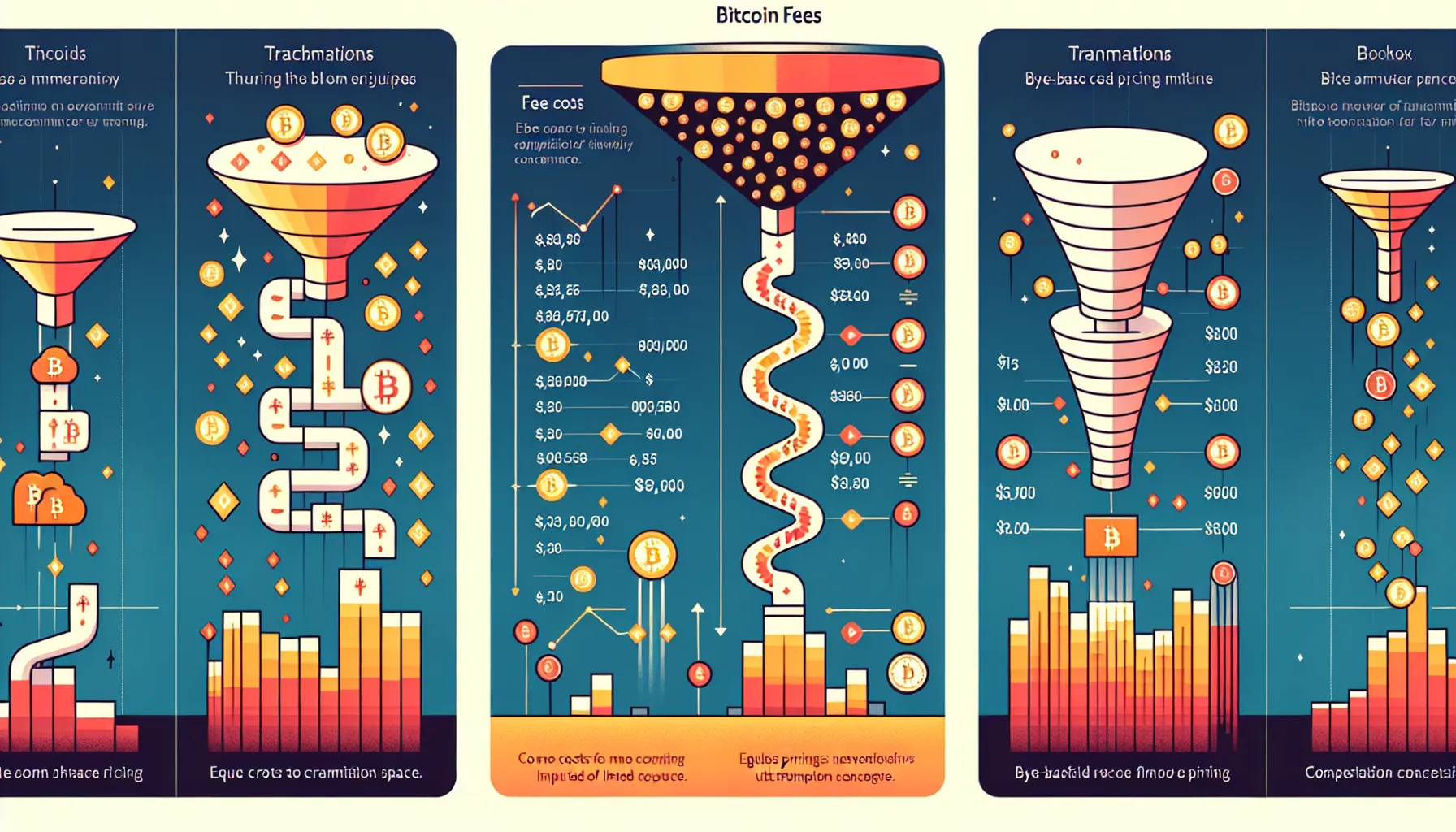Bitcoin transaction fees can spike dramatically during periods of high network congestion, leaving users frustrated and out of pocket. When demand for block space exceeds availability, miners prioritise transactions offering higher fees, creating a bidding war that drives costs skyward. Whether sending a small payment or settling a larger sum, nobody wants to pay more than necessary, especially when strategic timing and the right technical tools can slash those expenses significantly.
Understanding how Bitcoin fees work and why they fluctuate is the first step towards taking control. Unlike traditional banking fees tied to transaction amounts, Bitcoin fees depend on the data size of the transaction itself, measured in bytes. During busy periods, triggered by popular token mints, price volatility, or simply heavy weekend activity, limited block space forces users to compete for inclusion. The good news? With a few practical adjustments and wallet features, anyone can reduce fees substantially, even when the network is at its busiest. This guide explores proven methods to lower Bitcoin transaction costs during congestion, from timing transactions smartly to leveraging advanced technologies like the Lightning Network.
Key Takeaways
- Bitcoin transaction fees are determined by the data size of the transaction in bytes, not the amount being sent, making strategic transaction structuring essential to reduce costs.
- Timing transactions during off-peak hours, such as weekends or evenings, can reduce Bitcoin fees significantly compared to busy weekday trading periods.
- Using SegWit addresses (starting with ‘bc1’) can lower transaction fees by up to 40% compared to legacy address formats during high network congestion.
- Batching multiple payments into a single transaction drastically reduces per-recipient fees, making it ideal for businesses or users sending multiple payments.
- The Lightning Network provides an off-chain solution for small, frequent payments with minimal fees, bypassing Bitcoin network congestion entirely.
- Manually adjusting fee rates and enabling Replace-by-Fee (RBF) give users control to optimise costs whilst ensuring timely confirmation during volatile congestion periods.
Understanding Bitcoin Network Congestion and Transaction Fees

Bitcoin’s network operates on a simple premise: thousands of transactions compete for limited space in each new block, mined roughly every ten minutes. When demand for this space exceeds capacity, congestion occurs, and users must pay higher fees to incentivise miners to include their transactions quickly. This dynamic creates a fee market where timing, transaction structure, and wallet capabilities all influence how much one pays.
Congestion isn’t constant. It ebbs and flows based on network activity, global events, and user behaviour. During quiet periods, transactions can confirm with minimal fees, sometimes just a few pence. But when traffic surges, perhaps due to a surge in trading activity, new token launches, or speculative market moves, the mempool (the waiting area for unconfirmed transactions) fills rapidly, and fees can multiply tenfold or more within hours.
How Bitcoin Transaction Fees Are Calculated
A common misconception is that Bitcoin fees scale with the amount being sent. In reality, fees are determined by the transaction’s size in bytes, not the value transferred. Sending £10 or £10,000 in Bitcoin could incur the same fee if the transaction data is identical in size. This is because miners process data, not value, and block space is finite.
Transaction size depends on the number of inputs (previous transactions being spent) and outputs (addresses receiving funds). More inputs mean a larger transaction and, hence, a higher fee. The sender sets a fee rate, typically measured in satoshis per byte (sat/vB), and the total fee equals this rate multiplied by the transaction size. Higher fee rates result in faster confirmation because miners prioritise more profitable transactions.
Most wallets provide fee estimates based on current network conditions, offering options like “low,” “medium,” or “high” priority. These estimates help users balance cost against urgency, but they’re not always optimal, especially during volatile congestion periods when manual adjustments can save significant amounts.
Why Network Congestion Drives Fees Higher
Bitcoin’s block size is capped at approximately 1 megabyte (or 4 megabytes when accounting for SegWit adjustments), meaning only a fixed number of transactions fit into each block. When transaction volume exceeds this capacity, a backlog forms in the mempool. Miners, acting rationally, select transactions offering the highest fees to maximise their revenue.
This creates a bidding war. If a user wants their transaction confirmed in the next block, they must offer a fee competitive with others in the queue. During peak congestion, often coinciding with major market movements, popular NFT or Ordinals mints, or periods of heightened US trading activity, fees can spike from a few pence to several pounds per transaction. The limited throughput of the Bitcoin network, by design, makes this fee escalation inevitable during busy times.
Understanding these mechanics is crucial. Congestion isn’t a flaw: it’s a feature of Bitcoin’s decentralised, fixed-supply block space. But recognising how and why fees rise empowers users to adopt strategies that sidestep the worst of the cost increases.
Time Your Transactions Strategically
One of the simplest and most effective ways to reduce Bitcoin fees is to send transactions during off-peak hours. Network congestion follows predictable patterns tied to global activity, particularly trading hours in major markets. Weekday mornings and afternoons in the United States and Europe tend to see heavier traffic, while nights, weekends, and public holidays often experience lower demand.
By delaying non-urgent transactions until these quieter windows, users can avoid the fee spikes that accompany peak activity. The difference can be substantial: a transaction costing £5 during a busy Monday afternoon might confirm for under £1 on a Sunday morning. Of course, this strategy requires flexibility. Urgent payments won’t wait for optimal timing, but routine transfers, withdrawals, or consolidations can often be scheduled to take advantage of lower fees.
Some users make a habit of checking fee trends over several days before committing to a transaction. If fees are unusually high due to a temporary surge, say, a viral token launch or a sudden market rally, waiting a day or two can yield significant savings. Patience, in this context, translates directly into lower costs.
Monitor Network Activity Before Sending
Rather than guessing when fees might be lower, users can monitor real-time network activity using mempool tracking tools and fee estimation services. These platforms visualise the current state of the mempool, showing how many transactions are waiting and what fee rates are needed for fast, medium, or slow confirmation.
Popular tools display mempool size in megabytes, fee distributions across different priority levels, and estimated confirmation times for various fee rates. By consulting these resources before sending a transaction, users can choose a fee that matches their urgency without overpaying. If the mempool is bloated with high-fee transactions, it might be wise to wait. If it’s relatively clear, even a modest fee will confirm quickly.
Some wallets integrate fee estimation directly, pulling data from these services to suggest appropriate rates. But, external tools often provide more granular insights, allowing for better-informed decisions. Checking network activity before each transaction becomes second nature for cost-conscious Bitcoin users, transforming fee management from guesswork into a data-driven process.
Utilise SegWit Addresses for Lower Fees
Segregated Witness, or SegWit, is a protocol upgrade that restructures how transaction data is stored, effectively reducing the size of transactions and lowering fees. Introduced in 2017, SegWit separates signature data from transaction data, allowing more transactions to fit within each block. For users, this translates into smaller transaction sizes and, so, lower fees, often by as much as 40% compared to legacy address formats.
SegWit addresses begin with “bc1” (Bech32 format) and are supported by most modern wallets and exchanges. If a wallet still uses older address formats starting with “1” (Pay-to-PubKey-Hash) or “3” (Pay-to-Script-Hash), switching to a SegWit-compatible wallet can yield immediate savings. The reduction in transaction size means that even during congestion, SegWit transactions pay less per byte than their legacy counterparts.
Adoption has grown steadily, with a majority of Bitcoin transactions now using SegWit. For users who haven’t made the switch, the process is straightforward: select a wallet that supports SegWit, generate a new receiving address, and transfer funds. The savings accumulate over time, especially for frequent users or businesses processing multiple transactions daily. In an environment where every satoshi counts, SegWit is a low-effort, high-impact optimisation.
Batch Multiple Transactions Together
Batching is a technique where multiple payments are combined into a single transaction, significantly reducing the per-recipient fee. Instead of sending three separate transactions to three different addresses, each incurring its own fee, batching consolidates them into one, paying a single fee for all recipients. For businesses, exchanges, or individuals making multiple payments, this can halve or even quarter total fee costs.
The efficiency gain comes from how Bitcoin transactions are structured. Each transaction has a fixed overhead (inputs and basic metadata), regardless of how many outputs (recipients) it includes. Adding extra recipients increases the transaction size only marginally, so the fee per payment drops as more recipients are added. A single-output transaction might cost £2 in fees, while a five-output batched transaction might cost £3, saving £7 compared to sending five separate transactions.
Many wallets and exchanges now support batching natively, allowing users to queue payments and send them together. For businesses processing payroll, affiliate payments, or customer withdrawals, batching is a no-brainer. Even individual users can batch payments when settling debts or distributing funds among family or friends. The key is planning ahead: instead of sending payments as they arise, collect them and dispatch in a single transaction during a low-fee period.
Batching does require a bit more coordination and may not suit urgent, ad-hoc payments. But for scheduled or bulk transactions, the savings are undeniable, and the practice is becoming standard among cost-conscious Bitcoin users.
Adjust Your Fee Rate Manually
Most wallets offer default fee settings, typically labelled “low,” “medium,” or “high”, but these aren’t always optimised for current network conditions. During periods of fluctuating congestion, manually adjusting the fee rate can ensure a transaction confirms promptly without overpaying. Wallets that allow custom fee input give users direct control over the trade-off between speed and cost.
Setting a fee manually requires checking current mempool conditions and choosing a rate that matches the desired confirmation time. If immediate confirmation isn’t critical, a lower fee might result in a delay of an hour or more, but at a fraction of the cost. Conversely, if speed is essential, a higher fee ensures inclusion in the next block. The flexibility to adjust on the fly, based on real-time data, turns fee management into a strategic choice rather than a passive default.
Some wallets provide sliders or input fields for setting fees in satoshis per byte, while others allow users to specify a total fee amount. Understanding the relationship between fee rate, transaction size, and confirmation time is helpful here. A transaction of 250 bytes at 50 sat/vB will cost 12,500 satoshis, roughly £4 at current prices. Dropping to 20 sat/vB cuts the fee to £1.60, with perhaps a 30-minute delay. For many users, that trade-off is worthwhile.
Manual fee adjustment does require a bit of technical comfort and willingness to engage with mempool data. But once the process is familiar, it becomes a powerful tool for reducing costs across all transaction types.
When to Use Replace-by-Fee (RBF)
Replace-by-Fee (RBF) is a feature that allows users to increase the fee on an unconfirmed transaction, effectively “bumping” it higher in the mempool queue. If a transaction is sent with a low fee and later gets stuck due to rising congestion, RBF enables the sender to republish the transaction with a higher fee, incentivising miners to pick it up.
RBF is particularly useful during unpredictable congestion spikes. A user might send a transaction with a modest fee, expecting quiet network conditions, only to see a sudden surge in activity delay confirmation. Rather than waiting indefinitely or cancelling and resending, RBF allows a mid-flight correction, balancing initial cost savings with the need for timely confirmation.
Not all wallets support RBF by default, so users should enable the feature in wallet settings before sending transactions. Once enabled, any unconfirmed transaction can be replaced with a higher-fee version, usually through the wallet’s transaction history interface. The new transaction uses the same inputs and outputs but offers a more attractive fee to miners.
RBF is a safety net and an optimisation tool rolled into one. It encourages users to start with lower fees, knowing they can escalate if necessary, reducing costs on average while maintaining control over confirmation timing.
Consider the Lightning Network for Small Transactions
For small, frequent payments, the Lightning Network offers a compelling alternative to on-chain Bitcoin transactions. Lightning operates as a second-layer protocol, processing transactions off-chain through payment channels, with minimal fees and near-instant settlement. While it requires opening and closing channels with on-chain transactions, the bulk of activity happens off-chain, bypassing congestion entirely.
Lightning fees are typically a fraction of a penny, regardless of network congestion. This makes it ideal for micropayments, tipping, subscriptions, or any scenario where on-chain fees would be disproportionately high relative to the payment amount. Sending £2 via Lightning costs virtually nothing: sending the same amount on-chain during congestion might cost more in fees than the payment itself.
Adoption of Lightning has grown steadily, with increasing wallet support, merchant acceptance, and liquidity. Setting up a Lightning wallet is straightforward, and many modern wallets integrate both on-chain and Lightning functionality seamlessly. Users fund a channel with an on-chain transaction, then conduct unlimited Lightning payments until they close the channel, settling the final balance on-chain.
Lightning isn’t a universal solution, it’s best suited to smaller amounts and situations where both parties have Lightning capability. For large, infrequent payments, on-chain remains more appropriate. But for users making regular small transactions, Lightning dramatically reduces costs and eliminates the frustration of congestion-driven fee spikes.
Choose Fee-Efficient Wallets and Exchanges
The wallet or exchange used to send Bitcoin transactions plays a significant role in fee efficiency. Not all platforms are created equal: some offer robust fee customisation, SegWit support, batching, and RBF, while others rely on inflexible, high default fees that can’t be adjusted. Choosing a fee-efficient platform is a foundational step in reducing costs.
Wallets that support SegWit, manual fee adjustment, and RBF give users the tools needed to optimise every transaction. Open-source wallets often excel here, providing transparency and control. Some wallets also integrate real-time fee estimation and mempool monitoring, making informed decisions easier.
Exchanges vary widely in their fee practices. Some batch customer withdrawals, passing savings on to users, while others send individual transactions with high default fees. Checking an exchange’s withdrawal fee structure and whether they support SegWit or Lightning withdrawals can reveal significant differences. For frequent withdrawals, using an exchange with efficient batching or Lightning support can cut costs substantially.
Beyond technical features, user experience matters. A wallet that makes fee adjustment intuitive encourages better practices, while one that hides or complicates fee settings often results in overpayment. Researching and selecting platforms that prioritise fee efficiency is time well spent, yielding long-term savings and greater control over transaction costs.
Conclusion
Reducing Bitcoin fees during high network congestion isn’t about luck, it’s about strategy, tools, and awareness. By timing transactions to avoid peak periods, using SegWit addresses, batching payments, adjusting fees manually, and leveraging features like RBF, users can substantially lower costs even when the network is under pressure. For smaller, frequent payments, the Lightning Network offers an off-chain alternative that sidesteps congestion entirely.
The key is understanding how Bitcoin’s fee market operates and adopting practices that work with, rather than against, the network’s design. Congestion will always occur: it’s an inherent feature of Bitcoin’s fixed block space. But with the right approach, users can navigate busy periods efficiently, keeping more of their Bitcoin in their wallets rather than handing it over in unnecessary fees. Whether sending a single payment or managing dozens, these techniques empower anyone to transact smarter, cheaper, and with greater confidence.
Frequently Asked Questions
What causes Bitcoin transaction fees to spike during network congestion?
Bitcoin fees spike when transaction demand exceeds block space capacity. Miners prioritise transactions offering higher fees, creating a bidding war. This congestion often occurs during market volatility, token launches, or peak trading hours when the mempool fills rapidly.
How can I reduce Bitcoin fees when sending transactions?
You can reduce Bitcoin fees by timing transactions during off-peak hours, using SegWit addresses, batching multiple payments together, manually adjusting fee rates, and considering the Lightning Network for smaller payments. These strategies can cut costs significantly even during congestion.
What is the difference between SegWit and legacy Bitcoin addresses?
SegWit addresses (starting with ‘bc1’) restructure transaction data to reduce size, lowering fees by up to 40% compared to legacy addresses (starting with ‘1’ or ‘3’). Most modern wallets and exchanges support SegWit, offering immediate savings on transaction costs.
When is the best time to send Bitcoin to avoid high fees?
The best time to send Bitcoin is during off-peak hours, typically nights, weekends, and public holidays when network demand is lower. Avoiding weekday mornings and afternoons in the US and Europe can reduce fees substantially compared to busy periods.
Can I cancel a Bitcoin transaction if the fee is too low?
You cannot truly cancel a Bitcoin transaction, but if your wallet supports Replace-by-Fee (RBF), you can increase the fee on an unconfirmed transaction to speed up confirmation. This allows you to start with lower fees and adjust if congestion rises unexpectedly.
Is the Lightning Network safer than regular Bitcoin transactions?
The Lightning Network is generally safe for smaller payments and operates through payment channels with cryptographic security. However, it requires channel liquidity and online availability. For large amounts or maximum security, on-chain Bitcoin transactions remain the preferred method despite higher fees.








